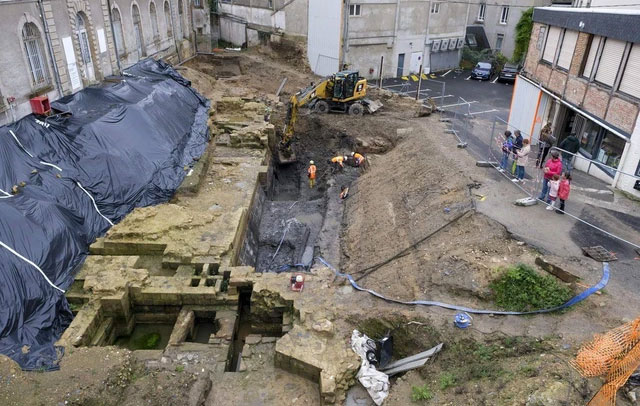Renovating a hotel, discovering a 600-year-old castle buried underground in France
A medieval castle was discovered in a very unexpected way in the city of Vannes in northwestern France.
According to Heritage Daily, the ancient castle was discovered right under the foundation of Château Lagorce , a private villa built in the 18th century and currently used as a hotel.
In the Middle Ages, the city of Vannes was the center of a principality called Bro-Wened (meaning "Vannes") or Bro-Ereg ("land of Gwereg").

Part of the castle was discovered in the hotel's courtyard - (Photo: Inrap).
Because it is a land with a rich history, scientists from the National Institute for Preventive Archaeological Research (Inrap) carefully examined the ground when the Château Lagorce hotel was renovated in preparation for building a museum. art.
During the first phase of excavation, the researchers conducted a study of the hotel's courtyard, where they discovered two levels of the castle's defensive walls and a moat, located at a depth of 4 m above street level. .
This over 600-year-old castle was built in the late 14th century by Jean IV, who held the titles Duke of Brittany and Count of Montfort from 1345, and 7th Earl of Richmond from 1372.
Known as Château de l'Hermine (Hermine's Castle), the structure aimed to assert Duke Jean IV's central authority over his duchy and the ancient town of Vannes.
According to Inrap, the remaining stonework shows that the castle had three to four floors and several staircases, one of the remarkably preserved parts.
The team also found traces on some stones that were processed to cover decorative walls and other auxiliary structures such as toilets and drainage pipes.
Many artifacts also represent the lives of the owners in the 15th and 16th centuries, including coins, knives, tiles, wooden bowls, kitchen utensils and some jewelry. Due to the condition of the soil, significant remains of items such as clothing, shoe buckles, pins, rings and locks remained.
Excavations also uncovered a mill connected to the castle's residential area, which had a large well fed by a canal, as well as the remains of a bridge connecting the castle to the rest of the castle. back of the old town.
- Norway: Discovering a 1,000-year-old ship of the Vikings underground
- Unique hotel planet: Guests sleep in Switzerland but must go to France to go to the bathroom
- The creepy mystery of the Iron Age skeleton buried in a strange position in the ancient castle
- Fontainebleau Castle - France
- The hotel with 16/18 floors below ground is about to open, priced from 11.3 million / 1 night
- Obsessed the 5 most terrifying haunted hotels in America
- Difficult mystery story in Edinburgh castle
- The story strayed into the underground world of the 5-year-old boy, confusing the scientists
- The largest 3,000-year-old castle on the bottom of Turkey
- Mysterious underground springs have not been solved in France
- Ancient chessboard in secret room in 13th century castle
- Why don't we make all the wires underground?
 Discovered an ancient centipede fossil 99 million years old
Discovered an ancient centipede fossil 99 million years old Discovered bat-like dinosaurs in China
Discovered bat-like dinosaurs in China Discovered a 200-year-old bronze cannon of the coast
Discovered a 200-year-old bronze cannon of the coast Discover 305 million-year-old spider fossils
Discover 305 million-year-old spider fossils